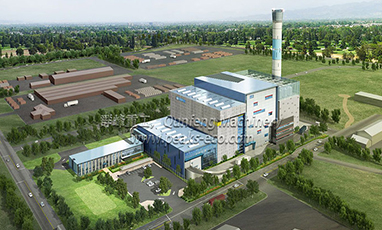2.1 Measures to reduce heat loss from exhaust smoke
For domestic waste incineration boilers, exhaust heat loss is the main heat loss of waste incineration boilers. The exhaust heat loss is mainly related to the exhaust temperature and excess air coefficient. When the excess air coefficient is constant, with the increase of the exhaust gas temperature, the exhaust heat loss gradually increases. When the exhaust temperature increases by 10°C, the exhaust heat loss increases by about 0.9%. When the exhaust gas temperature is constant, the excess air coefficient increases so does the exhaust smoke, and the exhaust heat loss increases accordingly. To reduce the heat loss of exhaust gas, there are two measures: reducing the exhaust gas temperature and reducing the excess air coefficient. In order to prevent low-temperature corrosion, the current typical exhaust gas temperature of municipal solid waste incineration boilers is generally between 190 and 200°C, which is 60 to 70°C higher than the exhaust temperature of about 130°C for conventional coal-fired units. A study on low-temperature corrosion of economizer tubes at different temperatures under the condition of waste incineration flue gas was carried out. The study found that, unlike the low-temperature corrosion caused by SO3 in conventional coal-fired units, the low-temperature corrosion caused by HCl caused the low-temperature corrosion of economizer tubes. The main cause of corrosion.
Reducing the excess air coefficient can also effectively improve the thermal efficiency of the waste incineration boiler. The excess air coefficient has a great influence on the combustion of garbage in the incineration boiler. Increasing the excess air coefficient can provide excess air, increase the turbulence in the furnace, and facilitate the full combustion of garbage. However, the excessive air coefficient may cause the temperature in the furnace to decrease and increase the energy required for conveying air and preheating air. Reducing the excess air factor may result in a decrease in the efficiency of waste incineration. Measures such as strengthening turbulent combustion and improving air distribution can reduce the concentration of combustibles such as CO under low excess air coefficient conditions and ensure the overall efficiency of waste incineration. For grate type waste incineration technology, air enters the furnace in the form of primary air and secondary air. The primary air is mainly responsible for the full conversion of solid waste on the grate, while the secondary air is mainly responsible for the full combustion of gaseous combustibles during the waste incineration process. The primary air excess air coefficient is mainly related to the calorific value of the garbage. The excess air coefficient of the primary air required for low calorific value garbage is generally higher to ensure the combustion reaction of the garbage in the bed to ensure the smooth progress of the garbage drying process.

Incineration System
2.2 Improve the main steam parameters
The MSW treatment plant can effectively improve thermal efficiency by improving the main steam parameters. The improvement of the main steam parameters of waste incineration power generation is mainly restricted by the anti-corrosion of the waste heat boiler (mainly high-temperature corrosion of flue gas). In recent years, due to the application of high-quality corrosion-resistant materials to boilers, the life of the heating surface of the boiler has been significantly improved. Although the investment and operating costs have increased, the overall economic benefits are better. The application of medium-temperature and sub-high pressure parameters has increased significantly, and the application of medium-temperature and Trends in the application of high pressure and ultra-high pressure parameters. It should be noted that when improving the main steam parameters, the exhaust steam humidity of the steam turbine and the boiler corrosion resistance must be taken into consideration.
2.3 Use intermediate reheat
The use of an intermediate reheating cycle can significantly improve the thermal economy of the incineration system. There are mainly two reheating methods currently used. One is the heating method with saturated steam outside the furnace; the other is the heating method with a reheater installed in the furnace. The first method is that the steam turbine usually adopts a split-cylinder method, and the high-pressure cylinder part uses For high-speed steam turbines, the high-pressure cylinder exhaust steam enters the steam reheater to reheat and then enters the low-pressure cylinder to continue working. In the second mode, the steam turbine can adopt a split-cylinder mode or a single-cylinder model.
Conclusion
When designing the efficiency improvement of waste incineration power generation, the specific conditions and requirements of waste incineration power generation should be based on specific conditions and requirements such as waste heat value, composition, treatment volume, pollutant discharge, etc., combined with the technical and economic comparison of schemes, and comprehensive selection of specific efficiency improvement measures adopted to ensure the improvement. The technical feasibility of the effective plan and the economic benefits of the project.